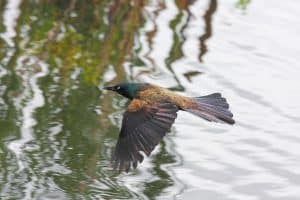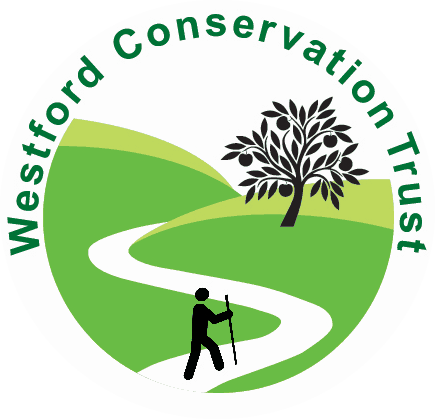
Where have all the birds gone? Many wildlife watchers have asked this question recently. Indeed, our feeders, after being in constant demand all summer, are now virtually empty of birds, save for an occasional goldfinch. As I recall, this is always a concern for feeder watchers at this time of year. There may be several reasons for this phenomenon. One thing to note is that there is plenty of natural food available. The woods are loaded with berries, nuts and insects, so the birds don’t need us as much.
Another factor is that juvenile birds have fledged and are now feeding themselves. Their parents no longer need to stuff several hungry mouths with food all day long. And an important factor is migration. Grackles and other blackbirds are now clustering into huge flocks, preparing for migration. We may see them at our feeders, but they quickly clean them out and move on. Hummingbirds filled up on sugar water and insects in the early part of September, and about mid-September they migrated south. Other birds have left too: warblers, catbirds, orioles, kestrels, cooper’s and broad-winged hawks. We are sorry to see them go; the woods are much quieter now. Some of the birds that we think of as year-round residents such as robins and jays, also move some distance south, and other robins and jays arrive here from Maine and Canada. We usually don’t notice that “our” robins are different robins than the ones we had this summer.
Most of our waterfowl have flown south, but some remain where there is open water. Some succumb to duck hunting season. There was an amusing quote about the hunting season printed in Bob Oliphant’s Westford Eagle column, “Museum Musings”, November 10, 2017. The quote is from the Westford Wardsman, November 10, 1917: “Hunters are busy firing at space and occasionally hit it–being more abundant than game. Keep right on, ladies and gentlemen, with the open season and we shall see where beautiful innocent bird life will be exterminated. But little is left now except grasshoppers, woodchucks and rats, about all else has either been killed off or frightened to death.”
One way to follow the progress of the migration season is to go to Cornell Lab of Ornithology’s website, BirdCast.info. On this fascinating site you can see the “BirdCast”, a three-day forecast of bird migration. Weather radar maps show birds migrating after sunset. They are updated every six hours. As I look at the map on October 2, it shows that Maine is experiencing a high level of migration intensity, and Massachusetts is showing a medium level. You can also watch a live migration map of your area in real time. Clicking on another map, one can see how “our” migrating birds navigated the major disruption of Hurricane Dorian that was moving up the coast in early September. Instead of migrating south along the coast as is typical, birds moved inland and caught tailwinds that speeded up their journey. We wish them safe travels.
Many thanks to all flora and fauna reporters for the month of October. Please send reports by November 26 to be printed in the next Westford Wildlife Watch. You can write to me at 7A Old Colony Drive, call me at 692-3907 or e-mail me at mariancharman@gmail.com
Late September Reports:
Marian/Bill Harman, at Hyacinth Lane, September 1, raven heard in woods, flicker heard at same location. At N. Caldwell Drive. September 10, pileated woodpecker heard clearly. At Old Colony Drive, September 29, a spotted orb weaver spider makes a beautiful big web on our deck railing every night. Five big tom turkeys in the yard.
October Reports:
Margaret and Mark Wheeler, Depot St. October 1, The game camera has caught what looks like a fox or coyote passing through around 3 a.m. the past two mornings [Looks like a coyote to me too-MH]
Carol Engel, Lowell Rd. October 5, Carolina wren in yard.
Marian/Bill Harman, Old Colony Drive. October 10, 57 degrees, rainy. Fourteen turkeys in yard. At Rt. 110, a pair of robins and a raven seen. October 11, 55 degrees, windy and rainy. A walk on the Pilgrim Village trails: two beautiful wood thrushes seen by Snake Meadow Brook. A nuthatch, chickadees, titmice, robins, fourteen turkeys in the woods. At the feeder, red-bellied woodpecker, and downy woodpecker. October 19, 57 degrees, sunny, beautiful. At the feeder, chickadee, titmouse, two goldfinches, a downy woodpecker, fourteen turkeys (females and young males) in yard. Lots of plain orange ladybugs flying around, stink bugs in and out of the house. October 22, 50’s sunny, beautiful, nice late fall colors. A small spider eating a grasshopper caught in its web, over a period of several days. October 23, a walk at East Boston Camps along Stony Brook: hairy woodpecker pecking on a tree and calling, red-bellied woodpecker, kingfisher heard, nuthatches, chickadees, titmice, many blue jays.
Marilyn Day, Graniteville Rd. October 12-13, We had a ton of ladybugs hatch on the south side of our house. They are the 15-spotted variety.
Doug Pederson, Woodland Drive. October 18, cabbage white butterflies, a Milbert’s tortoiseshell butterfly.
Debbie Prato, Hayrick Lane. October 25, two robins in back yard, Canada geese, phoebes, a bluebird checking out the birdhouse. Debbie notes that there is a new wildlife clinic opening at the Littleton Animal Hospital.
Mary Lyman, Tadmuck Lane. October 25, beautiful fungus growing on the bark of a tree in the back yard [Mary sent some very good photos-MH]
Marian Harman is a member of the Westford Conservation Trust, a non-profit conservation organization, whose purpose is the preservation of Westford’s open spaces and trails. The Trust welcomes new members and volunteers. Check out our website at westfordconservationtrust.org, and visit us on Facebook.
